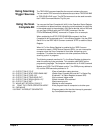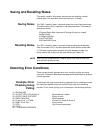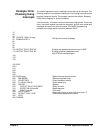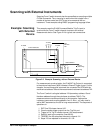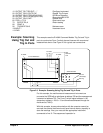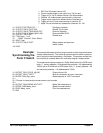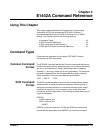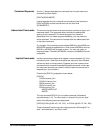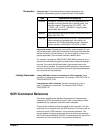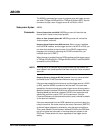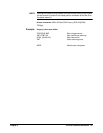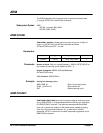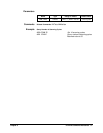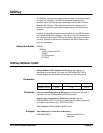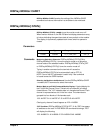
E1442A Command Reference 53Chapter 3
Parameters ParameterTypes. The following table contains explanations and
examples of parameter types you might see later in this chapter.
Optional Parameters. Parameters shown within square brackets ([ ]) are
optional parameters. (Note that the brackets are not part of the command
and are not sent to the instrument.) If you do not specify a value for an
optional parameter, the instrument chooses a default value.
For example, consider the ARM:COUNt? [MIN |MAX] command. If you
send the command without specifying a parameter, the present setting is
returned. If you send the MIN parameter, the command returns the
minimum count available. If you send the MAX parameter, the command
returns the maximum count available. Be sure to place a space between
the command and the parameter.
Linking Commands Linking IEEE 488.2 Common Commands with SCPI Commands. Use a
semicolon (;) between the commands. For example, *RST;OUTP ON or
TRIG:SOUR HOLD;*TRG
Linking Multiple SCPI Commands. Use both a semicolon (;) and a
colon (:) between the commands. For example, ARM :COUN 1;:
TRIG:SOUR EXT
SCPI Command Reference
This section describes the Standard Commands for Programmable
Instruments (SCPI) commands for the E1442A. Commands are listed
alphabetically by subsystem and within each subsystem.
There are two methods to send commands to the instrument. The first
method is from a controller over the GPIB interface. This method will be
referred to as the "GPIB interface" in the command reference. The
second method of sending commands is from a terminal connected to
the E1406 Command Module (RS-232). Commands sent this way will be
referred to as "from the terminal" in the command reference.
Type Explanations and Examples
Numeric Accepts all commonly used decimal representations of
numbers including optional signs, decimal points, and
scientific notation. Examples are 123, 123E2, -123,
-1.23E2, .123, 1.23E-2, 1.23000E-01. Special cases
include MIN, MAX and INF.
Boolean Represents a single binary condition that is either true or
false. (ON, OFF, 1.0).
Discrete Selects from a finite number of values. These parameters
use mnemonics to represent each valid setting. An
example is the TRIGger:SOURce<source> command
where <source> can be BUS, EXT, HOLD, or IMM.



